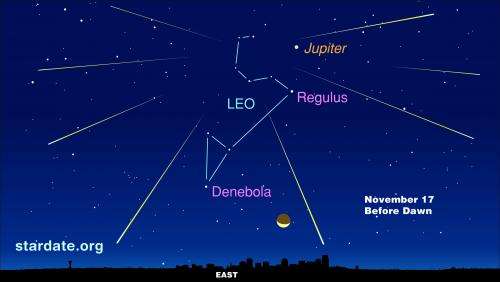A "streaky" meteor shower will be at its best before dawn on Monday, November 17, according to the editors of StarDate magazine. Unfortunately, this won't be one of its better years, as the partially illuminated Moon will wash out some of the meteors. Even so, the Leonid meteor shower should produce a "shooting star" every few minutes.
The best view comes in the wee hours of the morning when the shower's namesake constellation climbs into view—Leo, the lion. If you trace the paths of the meteors across the sky, they all appear to come from Leo.
The meteors are created by bits of rocky debris from a comet that orbits the Sun once every third of a century. Earth intersects the trail of comet dust every November. The bits of debris ram into the atmosphere at tens of thousands of miles an hour. They quickly vaporize, forming the glowing streaks known as meteors.
The trail is clumpy, though, with the biggest clumps near the comet itself. So every time the comet streaks through the inner solar system, the number of meteors goes up. Some years, the Leonids can produce hundreds of meteors an hour.
And some years, the Leonids produce not showers of meteors, but storms. In 1833, for example, so many meteors streaked across the sky that their light awakened sleeping Americans. And in 1966, the Leonids produced up to 50 meteors every second across parts of the southwest.
Credit: The University of Texas McDonald Observatory
This won't be one of those great years. Even so, the shower could still be worth a look as it reaches its peak in the wee hours of Monday and Tuesday.
Provided by University of Texas at Austin
























